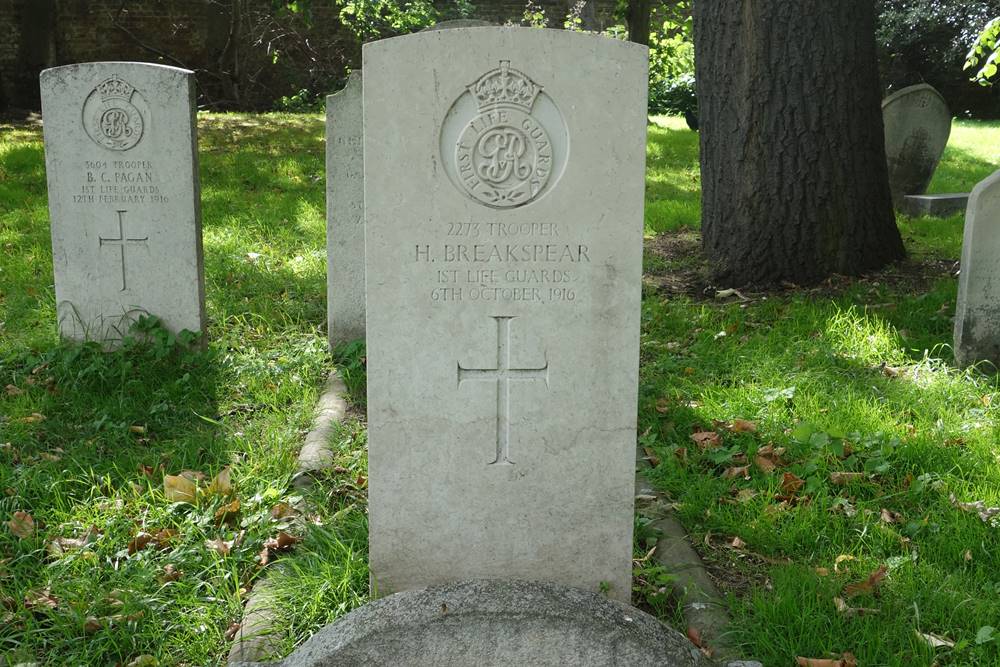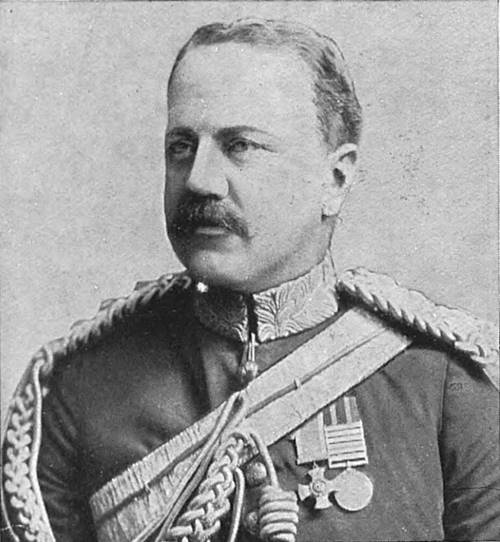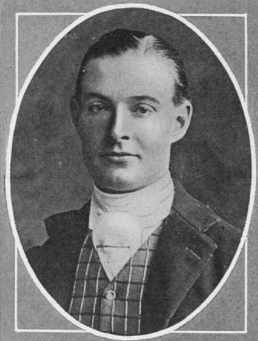This article on the 1st Life Guards will provide you with an overview of the activities of the Regiment during the First World War and will help you to research those who served with the unit. I have written a separate article for the 2nd Life Guards and a series of guides to help you research those who served during the war:
The 1st Life Guards in the First World War
The 1st Life Guards was stationed at Hyde Park Barracks, London when Britain declared war on Germany on 4 August 1914. The Regiment initially sent a squadron abroad as part of the Household Cavalry Composite Regiment which was formed from both Life Guards regiments and the Royal Horse Guards. This Regiment took part in the British Expeditionary Forces’ advance across France into Belgium and subsequent retreat. However, the Composite Regiment didn’t see much action until the Battle of Ypres in October and November 1914. The remainder of the 1st Life Guards landed at Zeebrugge, Belgium on 8 October 1914 and moved towards Ypres where it arrived on 14 October 1914. The Regiment’s squadron serving with the Household Cavalry Composite Regiment rejoined the 1st Life Guards at Verlorenhoek, on 11 November 1914. The Regiment served on the Western Front as part of the 7th Cavalry Brigade of the 3rd Cavalry Division until it was converted into a machine gun battalion in 1918. The 1st Life Guards was then redesignated as the 1st Guards Machine Gun Battalion. After the Armistice was signed on 11 November 1918, the 1st Guards Machine Gun Battalion reverted to the 1st Life Guards.
Researching a Soldier who served in the 1st Life Guards during the First World War
I have written a number of generic research guides covering how to find medal records, newspaper reports, gallantry awards etc. To find out more about the Regiment, I’d recommend downloading its war diary which I’ve discussed below and viewing a copy of the Life Guards: War Diary of the 1st Life Guards, First Year 1914-1915. This book contains approximately 150-200 names including all the Regiment’s casualties for the period.
Officers: Due to the aristocratic nature of the 1st Life Guards, it was the most exclusive regiment for officers in the pre-war army, its officers are usually easy to research. The first step is to see if their service record has survived at the National Archives. If there is no record in the National Archives catalogue then you can apply to the Household Cavalry Museum to see what their archive hold. The amount of information the Household Cavalry Museum hold will vary depending on the officer and they take a month or so to get back to you. Even if a service record is available at the National Archives it will still be beneficial to apply to the Household Cavalry Museum. If you are after a photograph, The Sphere, Tatler, and Illustrated London News are good newspapers to search.
A photograph of Lieutenant Sir Richard Levinge who was killed in action on 24 October 1914 while serving with the 1st Life Guards. It was published in The Tatler. There is no service record for Sir Richard at the National Archives but you’d be able to find out a lot about his service from the Regiment’s war diary, newspaper reports, regimental history, London Gazette etc.
Other Ranks: If you are researching a soldier who served in the 1st Life Guards during the First World War then you are in luck. The service records for other ranks weren’t stored in the War Office warehouse which caught fire during the Blitz and have survived. Providing the soldier in question ended their service with the Regiment their service record will either be:
- At the National Archives if a soldier was discharged from the 1st Life Guards between 1799 and 1920. These have been digitized and can be downloaded from the National Archives’ website for a small fee or viewed on FindmyPast. The catalogue reference is WO 400 and they can be searched here: Search 1st Life Guards Records at the National Archives.
- At the Household Cavalry Museum Archive which also holds the 2nd Life Guards service records. The archive charges a fee of £25 and I would highly recommend applying for the service record as it will contain information you will not be able to find elsewhere.
The service records in the WO 400 series are available on FindmyPast which has a free trial. Clicking on the banner below will take you to the website. You will also need to check the records available on Ancestry.
War Diary of the 1st Life Guards
There is a single war diary for the Regiment covering its service on the Western Front as a cavalry regiment which has been digitized by the National Archive. There is no war diary for the Household Cavalry Composite Regiment. There is a separate war diary for the 1st Guards Machine Gun Battalion which has also been digitized. To download the war diaries for a small fee, click on the blue links below.
- Date: 08 October 1914 – 31 March 1918
- 7th Cavalry Brigade, 3rd Cavalry Division
- Reference: WO 95/1155/1
- Notes: A good war diary for a British cavalry regiment serving on the Western Front. Unfortunately, there are no appendices. I have transcribed some of the entries below.
- Date: 01 April 1918 – 30 November 1918
- Army Troops
- Reference: WO 95/247/2
- Notes: An average war diary which mostly contains brief entries with little detail. Those killed and wounded in the air raid at Etaples on 19/20 May 1918 are recorded. There are no appendices.
Further Sources for the 1st Life Guards
If you are researching a soldier who served in the 1st Life Guards during 1914-15 I would highly recommend purchasing Life Guards: War Diary of the 1st Life Guards, First Year 1914-1915. This book contains hundreds of names and provides facts not found in the Regiment’s war diary from which it draws most of its information.
There was no full regimental history produced for the 1st Life Guards concerning its role during the First World War. However, the Regiment is covered in The Story of the Household Cavalry: Volume 3 by Sir George Arthur, Bart., assisted by Capt. Shennan Royal Horse Guards. This volume hasn’t been reprinted and can be quite difficult to obtain. I viewed a copy at the British Library. The Imperial War Museum holds two collections relating to officers who served with the 1st Life Guards:
- Private Papers of Major R. M. Cowie. Documents.16066 who was the Regiment’s medical officer early in the war.
- Private Papers of Lieutenant-Colonel E. B. Cook. Documents.12002 who commanded the Composite Regiment.
The war diaries of the 3rd Cavalry Brigade Headquarters will add further information regarding the 1st Life Guards before it was converted into a machine gun battalion. There is a single war diary WO 95/1154/1 covering the period between October 1914 and March 1919. A good book to give context regarding the role of British cavalry on the Western Front is Horsemen in No Man’s Land: British Cavalry and Trench Warfare 1914-1918 by David Kenyon.
Extracts from 1st Life Guards’ War Diary
08 October 1914 – 30 March 1918, 7th Cavalry Brigade, 3rd Cavalry Division, WO 95/1155/1
8 October 1914 – Zeebrugge – Headquarters and 1 Squadron disembarked and remained awaiting orders on the quay till 3.30 pm then marched slowly through Blankenberge. The column was considerably delayed in the streets of the town owing to non-receipt of orders. This was unfortunate as it led to the ranks being considerably broken by inhabitants offering hospitality. It seems undesirable for troops to remain halted in friendly towns.
8 October 1914 – 8 pm – Blankenberge – Orders received through officer commanding 2nd Life Guards to bivouac for the night. This was carried out on the shore 1/2 mile west of the town.
24-25 October 1914 – Zandvoorde – Remained in trenches for 48 hours. Trenches heavily shelled all day. Both nights heavy firing opened about 9 pm but no actual attack was made. Firing lasted about 1/2 an hour, and the same was repeated about 2 am. Reports and casualty list attached.
30 October 1914-Zandvoorde- At 7.30 am position was attacked by large force of infantry. This attack proved successful owing to greatly superior numbers. Regiment retired in good order about 10 am except C Squadron on left flank from which only about 10 men got back. Remainder of squadron missing. Also one machine gun put out of action. Regiment retired behind 6th Brigade, which turned out to support. 2nd Dragoons, 3rd and 4th Hussars also came to support but [?] did not come into action. Having gained Zandvoorde ridge enemy did not press the attack very vigorously and second position occupied by 6th Brigade was not attacked.


